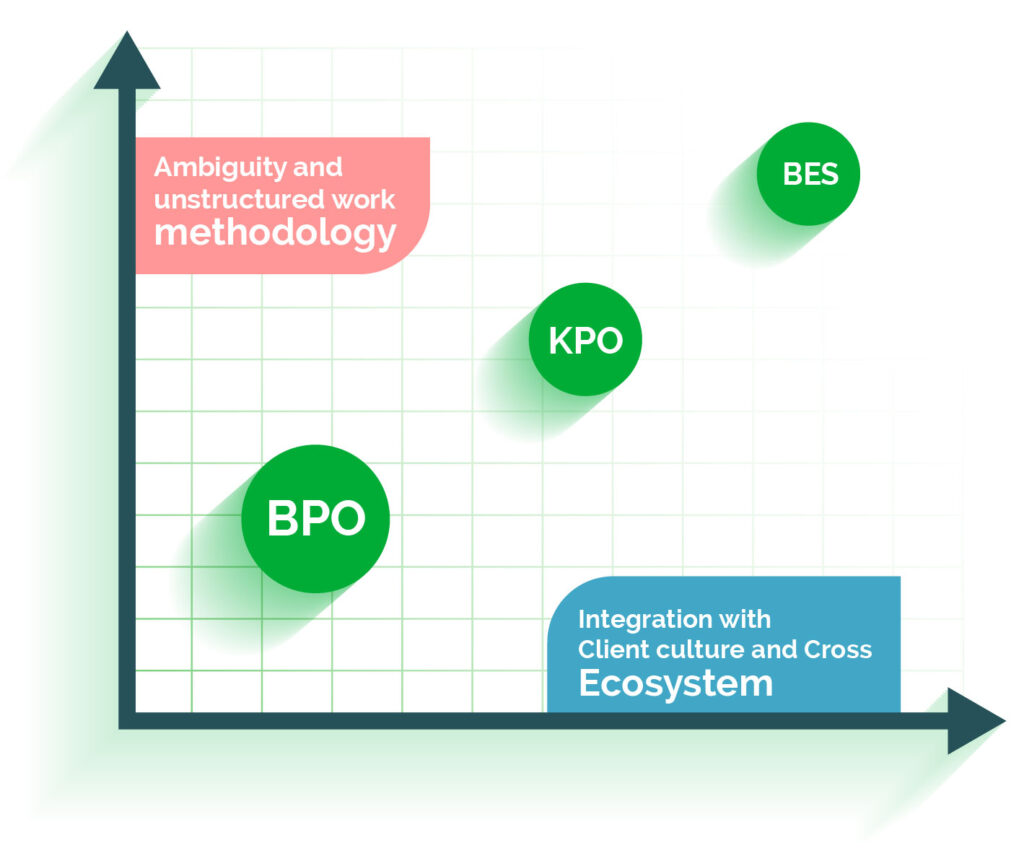
In my first article, I wrote about the evolution of Business Enablement Services. To recap, how the exponential growth in data and systems and transformation projects have accelerated the need for businesses to have a middle layer that bridges the gap between the strategic and the tactical/operational.
This growth exposed the limitations of existing service models like Business Process Outsourcing (BPO) or Knowledge Process Outsourcing (KPO) providers to fill this need. This inability stems from the specific needs of every organization and is influenced by the organization’s internal ecosystem around process, people, data, and technology – that the same solution applied elsewhere won’t work for another customer.

Where and How Does It Fit and the Key Differences
The key differentiator for Business enablement services from BPO and KPO Industry is the end result – while Business Enablement Services oscillate between Strategic and Tactical to ensure the success of transformation projects, BPO and KPO are cost-driven efforts. The second major difference is in the level of integration one has in BES with multiple functions of clients and accumulation of knowledge scope over a period.
The following graph shows the positioning of the Business Enablement Services with the size of the bubble corresponding to the size of the industry.

Following are a few more differences which are in no way exhaustive but should give you an idea of what Business Enablement Service is –
| Category | BPO | KPO | BES |
| Stands for | Business Process Outsourcing | Knowledge Process Outsourcing | Business Enablement Services |
| Definition | Provides services such as customer care, technical support, etc | Provides in-depth knowledge and complex areas like Legal Services, Market Research, etc | Provides services such as answering stakeholder questions on systems, processes, and data, creating leadership presentations, Adhoc Data queries for stakeholders, Adhoc analytics for leadership to decide during changing business landscape, other such activities that the business needs, etc. that help the business run its day-to-day operations in alignment with its strategic goals |
| Why | Businesses want to focus on their core activities and optimize by transferring what is non-Core | This kind of work needs expertise and specialization, and so businesses benefit from bringing in that experience | With increasing data and business process complexity and spending on transformation projects, businesses need a layer that can bridge the gap between the strategic and tactical and also meet the increasing demands of their internal and external stakeholders |
| Services | Low-End Services that have repeatability | High-End Services that require special expertise, e.g., Legal Knowledge, PhDs, Medical Knowledge, etc | A mix of services, both core, and non-core, with varied requirements that businesses need to efficiently align their operations with the objective of strategic transformation projects. Their operations. Staffed with People with multiple skills and business familiarity |
| Process | Pre-Defined Process | Skill and Expertise of Knowledge Employees | A mix of work with defined processes and some that need the application of knowledge gained in the engagement |
| Expertise | Process | Knowledge | Ability to learn fast, continuously move between the big picture as well as get into the details to see what will work, work in a fast-paced environment, connect the dots, and excellent execution |
| Relies on | Cost Arbitrage | Knowledge Arbitrage | Execution Time and Quality Arbitrage |
| Transition | Step by Step transition of the processes outsourced | Not much is needed since the vendor comes with expertise | Minimal because the knowledge is still with the Organization. We help with the execution using the knowledge gained in the engagement |
| Performance Metrics | Standard SLA is driven based on volume, turnaround times, and quality of execution | Standard SLA is driven based on insight output | Customized metrics to align with the client expectations, e.g., Team Utilization, Regrettable Attrition, Work Portfolio composition, Innovation or CSI examples, customer survey metrics, etc. It is not a one-time activity, but metrics evolve with the relationship as new projects get introduced |
| Nature of Work | Predefined Scope | Predefined Scope | Depends on the business demands and strategic direction that the organization is taking |
| Impact on Client Resources | Known to reduce resources on the client-side | Medium Impact | Strengthens the client team by acting as an extended team |
| Client Control on Vendor Staff | The vendor controls the people working on the engagement | The vendor controls the people assigned to the engagement | The client has the flexibility to review people working on the project and provide feedback related to fit. All resourcing decisions are taken with enough notice to the client |
| Impact on Knowledge of the Client Organization | No Knowledge Loss | Loss of Knowledge can occur | There is no Knowledge Loss as both the client and the vendor team learn together |
| Cultural Assimilation | Not Needed | Limited to the ways of communication | Very High – Ability to constantly pivot to align with the clients’ needs |
| Delivery Ownership | Responsibility and/or ownership of the process is delegated to the provider | Responsibility and/or ownership of the process is delegated to the provider | Joint ownership of certain key deliverables with responsibilities and accountabilities defined for every new project/activity. Vendor ownership of other deliverables after a go-ahead from the client |
BES as the Next Level Engagement Model
With an overlapping business objective to save cost and effort, BES has different features that serve a fundamental need of today’s customers – flawless last mile execution. Adapting the change with Business Enablement Services will enable organizations to choose between probable options and avail of the best feasible solution on a need basis.
In the third and last part of this series, I will give an example to show what Business Enablement Services can help you with and how it benefits you.
